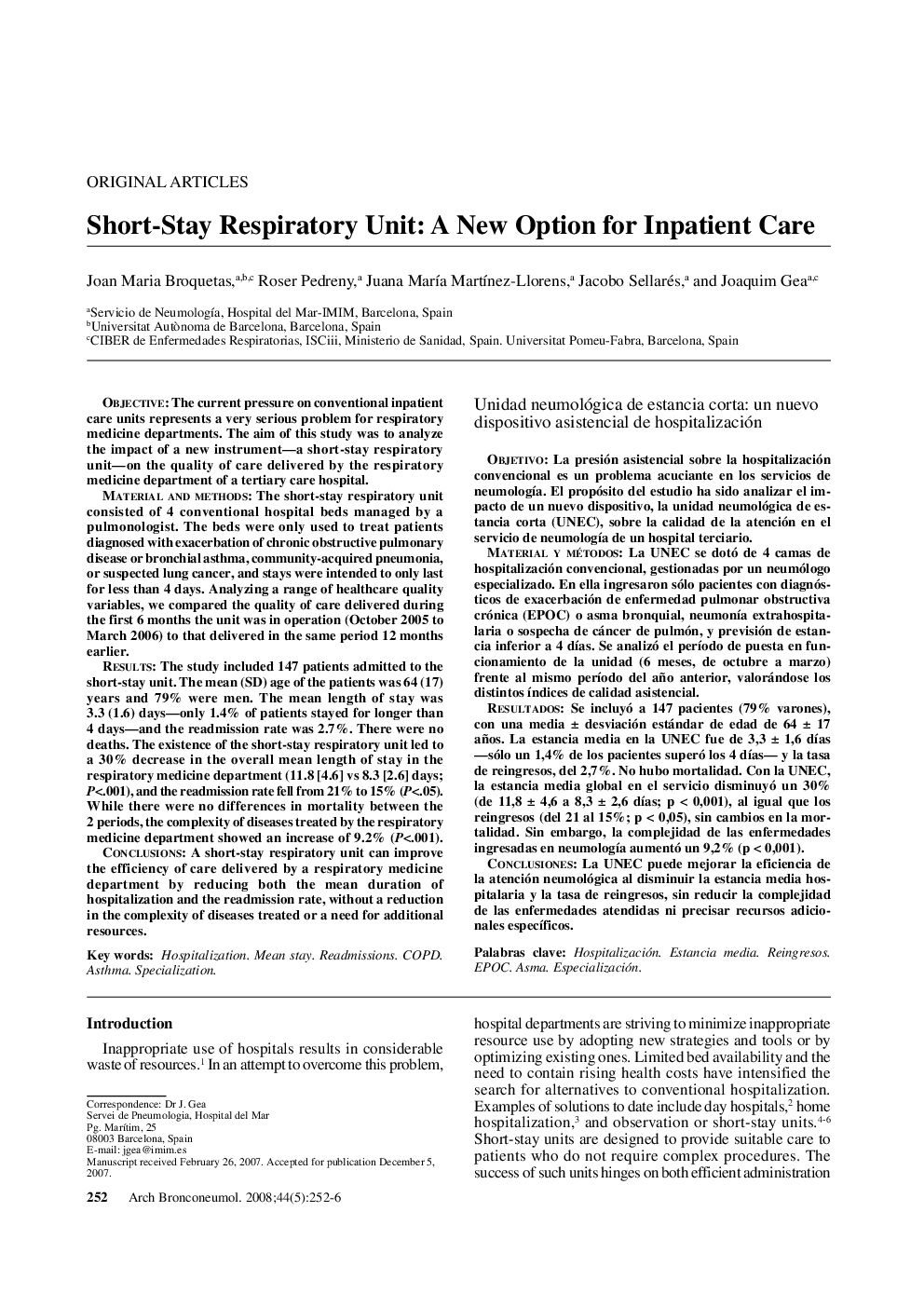| Article ID | Journal | Published Year | Pages | File Type |
|---|---|---|---|---|
| 4206828 | Archivos de Bronconeumología (English Edition) | 2008 | 5 Pages |
ObjectiveThe current pressure on conventional inpatient care units represents a very serious problem for respiratory medicine departments. The aim of this study was to analyze the impact of a new instrumenta short-stay respiratory uniton the quality of care delivered by the respiratory medicine department of a tertiary care hospital.Material and methodsThe short-stay respiratory unit consisted of 4 conventional hospital beds managed by a pulmonologist. The beds were only used to treat patients diagnosed with exacerbation of chronic obstructive pulmonary disease or bronchial asthma, community-acquired pneumonia, or suspected lung cancer, and stays were intended to only last for less than 4 days. Analyzing a range of healthcare quality variables, we compared the quality of care delivered during the first 6 months the unit was in operation (October 2005 to March 2006) to that delivered in the same period 12 months earlier.ResultsThe study included 147 patients admitted to the short-stay unit. The mean (SD) age of the patients was 64 (17) years and 79% were men. The mean length of stay was 3.3 (1.6) days-only 1.4% of patients stayed for longer than 4 days-and the readmission rate was 2.7%. There were no deaths. The existence of the short-stay respiratory unit led to a 30% decrease in the overall mean length of stay in the respiratory medicine department (11.8 [4.6] vs 8.3 [2.6] days; P < .001), and the readmission rate fell from 21% to 15% (P < .05). While there were no differences in mortality between the 2 periods, the complexity of diseases treated by the respiratory medicine department showed an increase of 9.2% (P < .001).ConclusionsA short-stay respiratory unit can improve the efficiency of care delivered by a respiratory medicine department by reducing both the mean duration of hospitalization and the readmission rate, without a reduction in the complexity of diseases treated or a need for additional resources.
ObjetivoLa presión asistencial sobre la hospitalización convencional es un problema acuciante en los servicios de neumología. El propósito del estudio ha sido analizar el impacto de un nuevo dispositivo, la unidad neumológica de estancia corta (UNEC), sobre la calidad de la atención en el servicio de neumología de un hospital terciario.Material y métodosLa UNEC se dotó de 4 camas de hospitalización convencional, gestionadas por un neumólogo especializado. En ella ingresaron sólo pacientes con diagnósticos de exacerbación de enfermedad pulmonar obstructiva crónica (EPOC) o asma bronquial, neumonía extrahospitalaria o sospecha de cáncer de pulmón, y previsión de estancia inferior a 4 días. Se analizó el período de puesta en funcionamiento de la unidad (6 meses, de octubre a marzo) frente al mismo período del año anterior, valorándose los distintos índices de calidad asistencial.ResultadosSe incluyó a 147 pacientes (79% varones), con una media ± desviación estándar de edad de 64 ± 17 años. La estancia media en la UNEC fue de 3,3 ± 1,6 días -sólo un 1,4% de los pacientes superó los 4 días- y la tasa de reingresos, del 2,7%. No hubo mortalidad. Con la UNEC, la estancia media global en el servicio disminuyó un 30% (de 11,8 ± 4,6 a 8,3 ± 2,6 días; p < 0,001), al igual que los reingresos (del 21 al 15%; p < 0,05), sin cambios en la mortalidad. Sin embargo, la complejidad de las enfermedades ingresadas en neumología aumentó un 9,2% (p < 0,001).ConclusionesLa UNEC puede mejorar la eficiencia de la atención neumológica al disminuir la estancia media hospitalaria y la tasa de reingresos, sin reducir la complejidad de las enfermedades atendidas ni precisar recursos adicionales específicos.
